Comparison of traffic signs in English-speaking countries
This is a comparison of road signs in countries that speak majorly English, including major ones where it is an official language and widely understood (and as a lingua franca).

Most road signs come in a different language rather than English. Example shows a road sign in Malta in Maltese language.
Botswana, Lesotho, Malawi, South Africa, Swaziland, Tanzania, Zambia, and Zimbabwe are all SADC members who drive on the left and use the SADC Road Traffic Signs Manual, and thus have identical road signs.
Differences between traffic signs in English speaking countries
Australia |
Canada |
Hong Kong |
Ireland |
Jamaica |
Liberia |
Mauritius |
NZ |
Nigeria |
Philippines |
RSA |
Sierra Leone |
Singapore |
UK |
USA | |
|---|---|---|---|---|---|---|---|---|---|---|---|---|---|---|---|
| Drives on... | Left | Right | Left | Left | Left | Right | Left | Left | Right | Right | Left | Right | Left | Left | Right |
| Typical typeface(s) |
_at_Exit_177_(U.S._Route_1%2C_Alexandria%2C_Fort_Belvoir)_in_Alexandria%2C_Virginia.jpg)
Most speed limits in the US use imperial. Also, the highway signs match the MUTCD in some English-speaking countries.
Differences in units

Metric signage reminder in Quebec, posted near US border

Road sign used in British Columbia, Canada, near the Canada–US border to remind American drivers that Canada uses the metric system.
Note that the imperial speed limit (left) is shown using a Canadian-style sign, rather than an MUTCD-standard one as would be used in the US
Note that the imperial speed limit (left) is shown using a Canadian-style sign, rather than an MUTCD-standard one as would be used in the US
- All countries, with except for the United States, and the United Kingdom, use the metric system. Some countries mark this fact by using units on various signs.
- Ireland, and parts of Canada (British Columbia, parts of Ontario, and Yukon) list units (km/h) on their maximum speed limit signs. In Canada and Ireland, this is a reflection of (somewhat) recent transitions from Imperial to metric.
- Advisory speed limit signs in most countries list units, although New Zealand does not. The US lists units in mph.
- Height, weight, and width restrictions are almost always accompanied by units (tonnes or metres); in the US, the short ton is used with no distinction from metric tonnes.
- Signs in some parts of Canada near the US border often include both metric and Imperial units, to remind American drivers that they are entering metric countries. No such equivalent exists in the US.[1]
- The US was, at one time, planning a transition to the metric system. The Metric Conversion Act of 1975 started the process, but it was halted in 1982. Nevertheless, the MUTCD specifies metric versions of speed limit signs. Furthermore, Interstate 19 in Arizona is partially signed in metric.
Color differences
Warning signs

Sheep road sign in the United Kingdom.
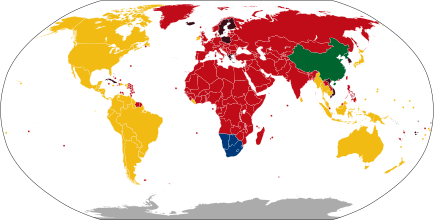
Countries in yellow use MUTCD-style diamond warning signs. Click for large image and detailed info key.
- Most warning signs are diamond-shaped and yellow or red-bordered triangular warning signs; some warning signs may be fluorescent yellow-green in order to draw extra attention. There are a few exceptions to this:
- Pentagonal signs are used in school zones in the United States, Liberia, and many areas in Canada. In the Philippines, pentagonal signs are permanently used for pedestrian crossings.
- Warning signs may be text-only.
Road works and construction
- Most countries use orange or yellow diamond-shaped signs or yellow, orange or white red-bordered triangular warning signs for construction zones. Australia and the Philippines use rectangular signs that fit into temporary casings.
Regulatory signs
- Prohibitory and restrictive signs are classified as regulatory signs.
- Almost all prohibitory signs use a red circle with a slash. Restrictive signs typically use a red circle, as in Europe. Some may be seated on a rectangular white background.
- The original MUTCD prohibitory and restrictive signs were text-only (i.e. NO LEFT TURN).[2] Some of these signs continue to be used in the US.
- Yield signs can be blank or have text with the legend "YIELD" or "GIVE WAY" depending on which country it is.
- The No Entry / Do Not Enter sign may or may not feature text. In Ireland, an upwards-pointing arrow contained within a slashed red circle is used instead. Some countries have those two signs separated.
- The Latin American-style do not proceed straight sign may take a different meaning in countries with standard No Entry signs. Typically, it indicates an intersection where traffic cannot continue straight ahead, but where cross-traffic may enter the street from the right (or left). Thus, it is distinguished from a No Entry (for all vehicles) sign.
Mandatory or permitted-action signs

Various color schemes for mandatory signs. Click for large image and detailed info key.
- The design of mandatory signs varies widely, since the MUTCD does not specify their use.[3] Rather, the MUTCD's equivalent are classified as regulatory signs.
- Some countries use simple arrows with the text "ONLY" or its equivalent underneath. This is the US and Australian standard.
- Some countries use European-style white-on-blue circular signs. These are "Type A Mandatory Signs" as prescribed by the Vienna Convention.
- Some Latin American countries use red-bordered circular signs, in the same style as regulatory signs. These are "Type B Mandatory Signs" as prescribed by the Vienna Convention. In cases relating to particular types of vehicle traffic (e.g. buses), these signs are identical to some European prohibitory signs.[lower-alpha 1]
- Canada uses a unique style of mandatory sign that features a green circle.
Warning
Australia |
Canada |
Hong Kong |
Ireland |
Jamaica |
Liberia |
Mauritius |
NZ |
Nigeria |
Philippines |
SADC |
Sierra Leone |
Singapore |
UK |
USA | |
|---|---|---|---|---|---|---|---|---|---|---|---|---|---|---|---|
| Stop ahead |  |
 |
? |  |
 |
 |
 |
 |
 |
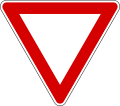 |
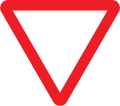 |
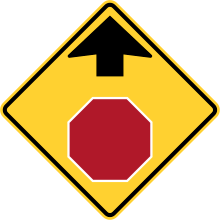 | |||
| Yield / Give Way ahead |  |
 |
? |  |
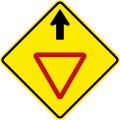 |
 |
 |
 |
 |
 |
 |
 | |||
| Traffic signals ahead |  |
 |
 |
 |
 |
 |
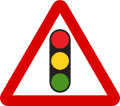 |
 |
 |
 |
 |
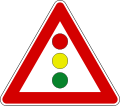 |
 |
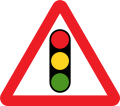 |
 |
| Roundabout ahead |  |
 |
 |
 |
 |
 |
 |
 |
 |
 |
 |
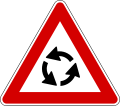 |
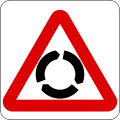 |
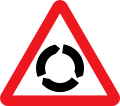 |
 |
| Two-way traffic ahead |  |
 |
 |
 |
 |
 |
 |
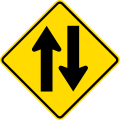 |
 |
? | 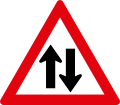 |
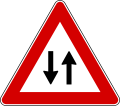 |
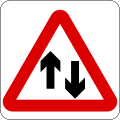 |
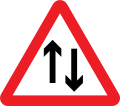 |
 |
| Uncontrolled railroad crossing ahead | Not used |  |
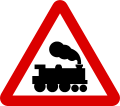 |
.svg.png) |
 |
 |
 |
Not used[lower-alpha 2] | 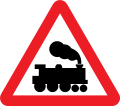 |
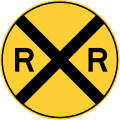 | |||||
| Level railroad crossing with barriers ahead |  |
 |
 |
 |
 |
 | |||||||||
| Tram / streetcar crossing |  |
Not used |  |
.svg.png) |
 |
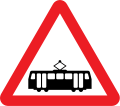 |
 | ||||||||
| Railroad crossbuck | or |
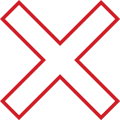 |
Not used |  |
or |
or |
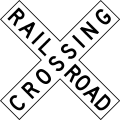 | ||||||||
| Level crossing (multiple tracks) | or .svg.png) |
Not used |  | ||||||||||||
| Crossroads ahead |  |
 |
 |
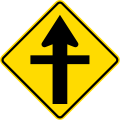 |
 |
 or[lower-alpha 3] 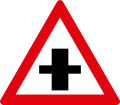 or[lower-alpha 4]  |
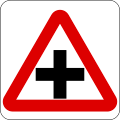 |
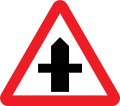 |
 | ||||||
| Junction with a side road ahead | |||||||||||||||
| Traffic merges ahead | |||||||||||||||
| Added lane | |||||||||||||||
| Divided highway ahead | |||||||||||||||
| Divided highway ends | |||||||||||||||
| Lane ends ahead | |||||||||||||||
| Road narrows ahead | |||||||||||||||
| Narrow bridge ahead | |||||||||||||||
| Dangerous crosswinds | Not used |  |
 |
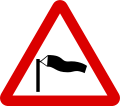 |
 |
 |
Not used | 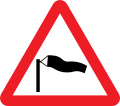 |
 | ||||||
| Low-flying aircraft |  |
 |
 |
 |
 |
 or  |
 |
 |
 |
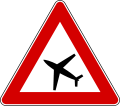 |
 |
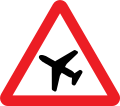 or 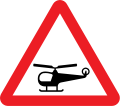 |
Not used[lower-alpha 5] | ||
| Steep hill downwards |  |
 |
.svg.png) |
 |
 |
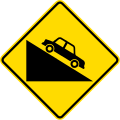 or  |
 or  |
 |
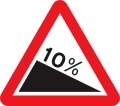 |
 | |||||
| Steep hill upwards | 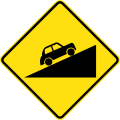 |
.svg.png) |
 |
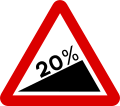 |
 or  |
 or  |
 |
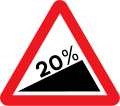 | |||||||
| Use low gear | |||||||||||||||
| Uneven surface |  |
 |
 |
 |
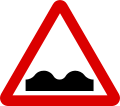 |
 |
 |
 |
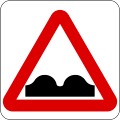 |
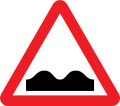 |
 | ||||
| Bump in road ahead |  |
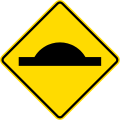 |
 | ||||||||||||
| Dip in road |  |
 |
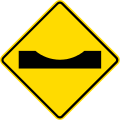 |
 | |||||||||||
| Speed hump |  |
 |
 |
 | |||||||||||
| Slippery road surface | |||||||||||||||
| Loose road surface | |||||||||||||||
| Pavement ends | |||||||||||||||
| Gentle curve ahead | |||||||||||||||
| Sharp curve ahead | |||||||||||||||
| Double gentle curve ahead | |||||||||||||||
| Double sharp curve ahead | |||||||||||||||
| Series of curves ahead | |||||||||||||||
| Hairpin curve ahead | |||||||||||||||
| School zone | |||||||||||||||
| Children / playground ahead | 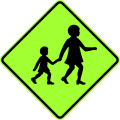 |
 |
 or  |
 |
 |
.svg.png) |
 |
 |
 |
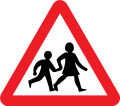 |
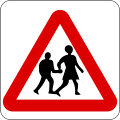 |
 |
 | ||
| Pedestrian crossing ahead | |||||||||||||||
| Pedestrians on road ahead | |||||||||||||||
| Domestic animals | |||||||||||||||
| Wild animals | |||||||||||||||
| Cyclists crossing | |||||||||||||||
| Trucks crossing | |||||||||||||||
| Equestrians | |||||||||||||||
| Emergency vehicles | |||||||||||||||
| Farm vehicles | |||||||||||||||
| Falling rocks or debris | |||||||||||||||
| Opening or swing bridge | 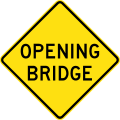 |
 |
Not used |  |
 |
Not used |  |
 |
 |
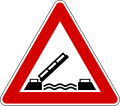 |
Not used | 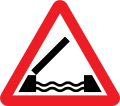 |
 | ||
| Tunnel ahead | Not used |  |
 |
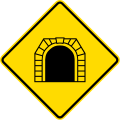 |
 |
 |
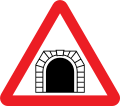 |
Not used[lower-alpha 5] | |||||||
| Height restriction ahead | |||||||||||||||
| Width restriction ahead | |||||||||||||||
| Length restriction ahead | |||||||||||||||
| Weight restriction ahead | |||||||||||||||
| Roadworks [lower-alpha 6] |
 |
 |
 |
 |
 |
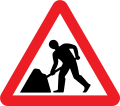 |
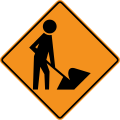 | ||||||||
| Other danger | |||||||||||||||
Regulatory
Priority
Australia |
Canada |
Hong Kong |
Ireland |
Jamaica |
Liberia |
Mauritius |
NZ |
Nigeria |
Philippines |
SADC |
Sierra Leone |
Singapore |
UK |
USA | |
|---|---|---|---|---|---|---|---|---|---|---|---|---|---|---|---|
| Stop |  |
 |
 |
 |
 |
 |
 |
 |
 |
 |
 |
 |
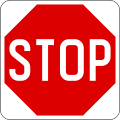 |
 |
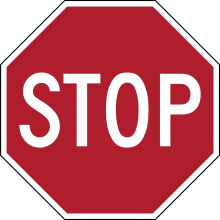 |
| Yield / Give Way | 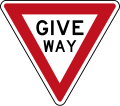 |
 |
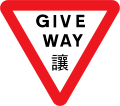 |
.svg.png) or .svg.png) |
 |
 |
 |
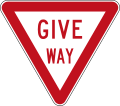 |
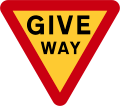 |
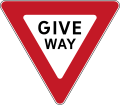 |
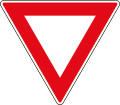 |
 |
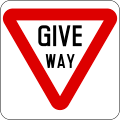 |
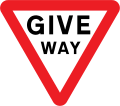 or .svg.png) |
 |
| Yield to oncoming traffic |  |
 |
? | .svg.png) |
 |
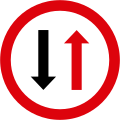 |
 |
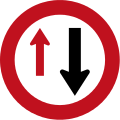 |
 |
 |
 |
 |
 |
 |
Prohibitory
Australia |
Canada |
Hong Kong |
Ireland |
Jamaica |
Liberia |
Mauritius |
NZ |
Nigeria |
Philippines |
SADC |
Sierra Leone |
Singapore |
UK |
USA | |
|---|---|---|---|---|---|---|---|---|---|---|---|---|---|---|---|
| No entry | 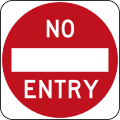 or[lower-alpha 7] |
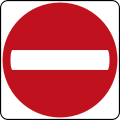 |
 |
(no exceptions:) (exceptions apply:) 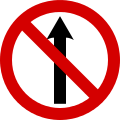 |
 |
 |
 |
 |
 |
 |
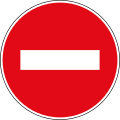 |
 |
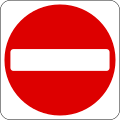 |
 |
 |
| Road closed/Vehicles prohibited | or |
 |
 |
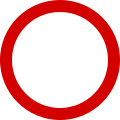 |
 |
 |
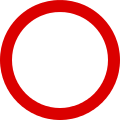 |
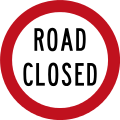 |
 |
? |  |
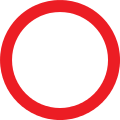 |
|||
| No motor vehicles |  |
 |
 |
 |
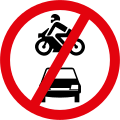 |
 |
Not used | 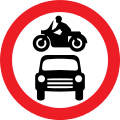 |
 | ||||||
| No motorcycles |  |
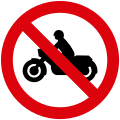 |
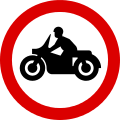 |
 |
 |
 |
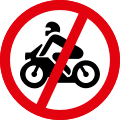 |
 |
 |
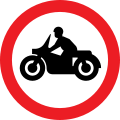 |
 | ||||
| No bicycles |  |
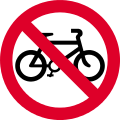 |
 |
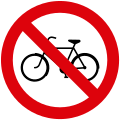 |
 |
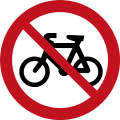 |
 |
 |
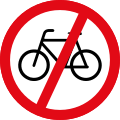 |
 |
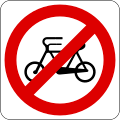 |
 |
 | ||
| No pedestrians |  |
 |
 |
 |
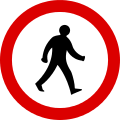 |
 |
 |
 |
 |
 |
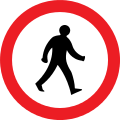 |
||||
| No heavy goods vehicles | 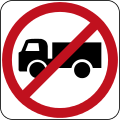 |
 |
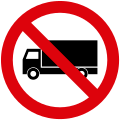 |
 |
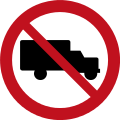 |
 |
 |
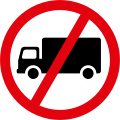 or  |
 |
 |
.svg.png) |
 or  | |||
| No vehicles carrying dangerous goods |  |
 |
 |
 |
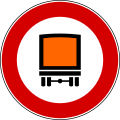 |
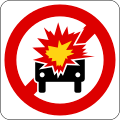 |
 |
 | |||||||
| No vehicles carrying explosives |  |
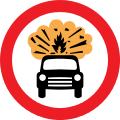 |
Not used | ||||||||||||
| Minimum safe following distance between vehicles |  |
Not used | |||||||||||||
| Maximum speed limit | .svg.png) |
 |
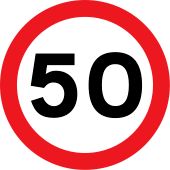 |
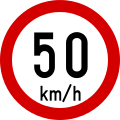 |
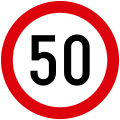 |
 |
.svg.png) |
 |
 |
.svg.png) |
 |
 |
 |
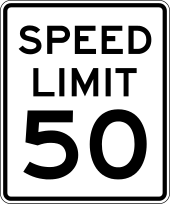 | |
| Speed restriction ends | |||||||||||||||
| Maximum height | |||||||||||||||
| Maximum width | |||||||||||||||
| Maximum length | |||||||||||||||
| Maximum weight | |||||||||||||||
| Maximum weight per axle | |||||||||||||||
| No left turn | .svg.png) or[lower-alpha 7] |
 |
 |
 |
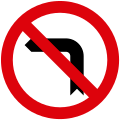 |
 |
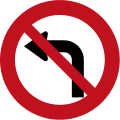 |
 |
 or |
 or 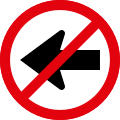 |
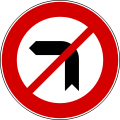 |
 |
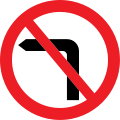 |
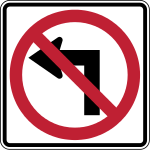 | |
| No right turn | .svg.png) or[lower-alpha 7] |
 |
 |
 |
 |
 |
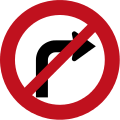 |
 |
 or |
 or 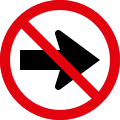 |
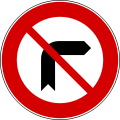 |
 |
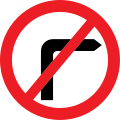 |
 | |
| No U-turn | 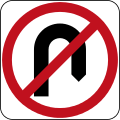 or[lower-alpha 7] |
 |
 |
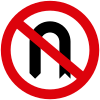 |
 |
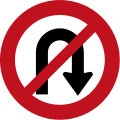 |
 |
 or |
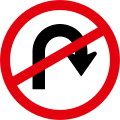 |
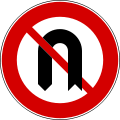 |
Not used[lower-alpha 8] | 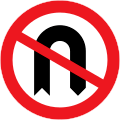 |
 | ||
| No overtaking |  |
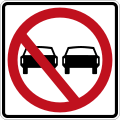 |
 |
 |
 |
 |
? |  |
 or |
 |
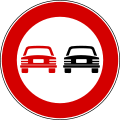 |
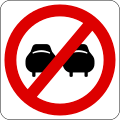 |
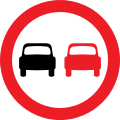 |
 | |
| No parking | |||||||||||||||
| No stopping |
Mandatory or permitted actions
Mandatory signs indicating an obligation to turn left do exist, but are not included in the list below since they are functionally mirror versions of signs indicating an obligation to turn right.
Australia |
Canada |
Hong Kong |
Ireland |
Jamaica |
Liberia |
Mauritius |
NZ |
Nigeria |
Philippines |
SADC |
Sierra Leone |
Singapore |
UK |
USA | |
|---|---|---|---|---|---|---|---|---|---|---|---|---|---|---|---|
| Proceed straight (no turns) |
 |
 |
 |
 |
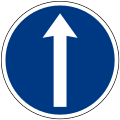 |
 |
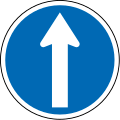 |
 |
 |
 |
 |
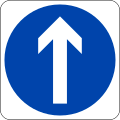 |
 |
||
| Turn right |  |
 |
 |
 |
 |
 |
 |
 |
 |
 |
 |
||||
| Turn right ahead |
 |
 |
 |
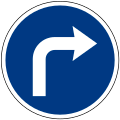 |
 |
 |
 |
 |
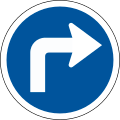 |
 |
 |
 |
|||
| Proceed straight or turn right | |||||||||||||||
| Keep right (or left) | |||||||||||||||
| Pass on either side | |||||||||||||||
| Roundabout | |||||||||||||||
| Minimum speed limit | |||||||||||||||
| Overtaking permitted [lower-alpha 9] | |||||||||||||||
| Pedestrians only | |||||||||||||||
| Bicycles only | |||||||||||||||
| Shared use path | |||||||||||||||
| Transit only |
Other
Australia |
Canada |
Hong Kong |
Ireland |
Jamaica |
Liberia |
Mauritius |
NZ |
Nigeria |
Philippines |
SADC |
Sierra Leone |
Singapore |
UK |
USA | |
|---|---|---|---|---|---|---|---|---|---|---|---|---|---|---|---|
| One-way street | |||||||||||||||
| Two-way traffic | |||||||||||||||
| Pedestrian crossing | |||||||||||||||
| Bump in road | |||||||||||||||
| Dead end | |||||||||||||||
| Escape lane | |||||||||||||||
| Tunnel | |||||||||||||||
| Speed limit zone | |||||||||||||||
| No parking zone | |||||||||||||||
| Parking zone | |||||||||||||||
| Hospital | |||||||||||||||
| Bus stop | |||||||||||||||
| Train station | |||||||||||||||
| Airport | |||||||||||||||
| Freeway begins | |||||||||||||||
| Freeway ends | |||||||||||||||
| Customs post | |||||||||||||||
| National highway shield(s) |
See also
Notes
- ↑ Compare Bicycles Only (Ciclovia) sign in Brazil:


- ↑ The last level crossing in Singapore closed in 2011, and thus train-related traffic signs became obsolete.
- ↑ Signs below used for crossroads with priority.
- ↑ The sign below is a uniquely Tanzanian version of the sign above.
- 1 2 No equivalent sign in the national MUTCD. Individual state MUTCDs may include equivalent.
- ↑ Temporary use only.
- 1 2 3 4 Top sign used in Queensland, South Australia, Tasmania, Victoria, and Western Australia. Bottom sign used in the Australian Capital Territory, New South Wales, and the Northern Territory.
- ↑ In Singapore, U-turns are forbidden per default, unless specifically allowed by a sign. While unofficial "U-turn prohibited" signs do exist, they only serve as a reminder, and the prohibition would still have been in place without the sign.
- ↑ In many jurisdictions, "Overtaking Permitted" is indicated solely through a change in road markings, e.g. a solid center line changing to a dashed center line. In such jurisdictions, signs in this category are only posted in locations where a change in road markings is deemed insufficient notice for drivers. This is in contrast to "No Overtaking" signs, which are almost always posted alongside changes in road markings to indicate the end of an overtaking zone.
References
This article is issued from
Wikipedia.
The text is licensed under Creative Commons - Attribution - Sharealike.
Additional terms may apply for the media files.